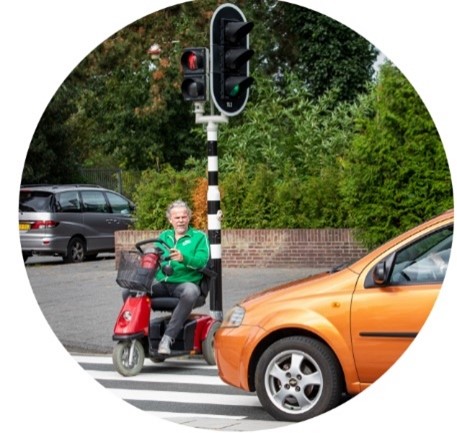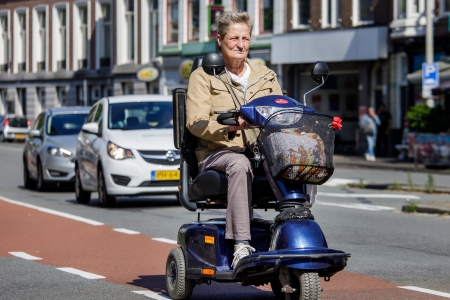Common causes and scenarios of mobility scooter crashes are: incorrect use of the throttle (squeezing instead of releasing), tipping of the often unstable mobility scooter because of unevenness of the road surface, bumping into a kerb or passing halfway across a kerb, a sudden swerving manoeuvre, or an intentional or unintentional priority error. There are no data available about the (concurrent) causes of crashes with enclosed disability vehicles and microcars.
The in-depth SWOV study of mobility scooter crashes [5] [6] distinguished four crash types which could describe 32 of the 35 crashes studied. They involve a combination of the conflict type and some decisive crash factors. The crash types are:
|
|
1. Mobility scooter user squeezes the throttle to brake, whereas it should have been released, and ends up in the water (n = 5). The vehicle design is conducive to the crash: a different mode of operation might have prevented the crash. |
|
|
2. The mobility scooter gets out of balance after contact with an obstacle or bump, which causes the user to take a fall (n = 8). This crash type is caused by infrastructural factors combined with the instability of mostly three-wheeled mobility scooters: narrow bicycle tracks and sharp bends impede manoeuvring and contact with e.g. a kerb makes the mobility scooter tip over. |
|
|
3. Swerving manoeuvre of the mobility scooter user prevents a collision, but results in the user taking a fall (n = 8). User behaviour also plays a part here, in combination with the vehicle instability: the mobility scooter user tries to prevent a collision by an abrupt steering manoeuvre. A collision is indeed prevented, but the vehicle is so unbalanced that it tips over. |
|
|
4. A mobility scooter user crosses the road or continues straight on and collides with crossing motorised traffic regardless of who has priority (n = 11). Again, behaviourial factors are involved: either the driver of the car or the user of the mobility scooter wrongly denies right of way, for example because the other road user is overlooked (insufficient visibility, distraction?). |
In a study by VeiligheidNL [10] 115 ER-treated casualties of mobility scooter crashes were asked to indicate which factors triggered the occurrence of their crashes which took place in 2011. Figure 6 shows which of the 11 causes were chosen by what percentage of respondents (respondents could choose more than one factor; on average they chose 1.5 factors).
 Figure 6. Factors that caused or contributed to the mobility scooter crash. Source: [10]
Figure 6. Factors that caused or contributed to the mobility scooter crash. Source: [10]




